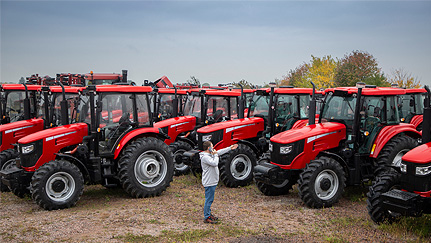Some farmers replace machinery every year. Others run it until the wheels fall off.
Where you fall in the range between those two extremes determines how to best approach evolving your farm machinery lineup. The right machinery replacement strategy can help ensure you’ve got what you need to continue to evolve your business well into the future.
Farm machinery and equipment costs changes over time. Things like depreciation, risk management expenses and increasing operating and maintenance costs affect how you approach the machinery replacement decision. Among these other variables, consider risk management in making an informed, financially smart decision.
Consider the downstream effects of machinery upgrades
If you normally trade tractors every five years and are looking to extend that by a couple years to save money, think about how that change will affect your farm in the long term, according to Nationwide Senior Consultant Erin Cumings. Trading machinery even a year later than normal affects things like residual value and available replacements.
Inflation has caused machinery costs to escalate at a time where parts availability could also impact our ability to keep our existing equipment running,
Cumings said. When you consider these types of factors, we can’t lose sight of business continuity, or what you do in the case of down-time, especially for key pieces of machinery.
5 things to think about when looking to replace machinery
An informed machinery replacement strategy accounts for five variables, according to retired Iowa State University Extension economist William Edwards:
- Reliability. A breakdown at the wrong time of the year can be costly. Think about the cost of such breakdowns and how important it is to your operation.
- Pride. Many farmers take pride in their machinery. Is that preventing you from other capital investments to preserve your farm’s longevity?
- New tech. Technology advancements happen quickly. It’s important to weigh the cost of new technology as your farm and machinery needs change.
- Capacity. Size and capacity may justify upgrades to increase your machinery capabilities. Balance time, labor and capacity in deciding if it’s time to upgrade.
- Machinery market. Keep tabs on your local machinery marketplace to determine what is financially feasible if you’re weighing a trade or upgrade.
How to think about insurance in making your decision
How your machinery replacement plan fits into a broader business continuity strategy should incorporate risk management. Fortunately, policy options like Replacement Cost coverage can help ensure you’re adequately compensated if you incur a loss. And there are other policy and endorsement options for just about any replacement strategy, according to Cumings. Just confirm what you need and what it will cost before you step into the machinery dealership.
If you’re considering adjusting your machinery replacement strategy to limit the risk of down-time, it’s important to know what is and isn’t covered,
Cumings said. Your farm insurance from Nationwide may include limited coverage for borrowed, rented or leased equipment. But that generally excludes damage from wear and tear or mechanical breakdowns. It’s important to talk to your agent about your coverage needs.
If you’re thinking about replacing machinery, talk to your Nationwide Farm Certified agent to confirm your coverage options and their cost.
